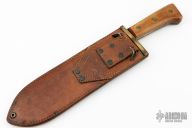Overview
Broad, non-tapering chopping blade swelling towards the point, with round tip and false edge, 11 3/8 inches long, 16½ inches overall. Thick wood scale grips secured by three brass rivets to the exposed tang. Brown leather scabbard with brass throat piece, webbing hooks and grommet hole at the chape.
The blade is stamped on one side with ‘U.S.M.C. Chatillon, N.Y.’, indicating use by the United States Marine Corps and the manufacturer John Chatillon & Sons of New York. ‘USMC Boyt 45’. Boyt was the only manufacturer of the scabbard, from 1942-45.
The Hospital Corps Knife was originally a tool issued to U.S. Navy Hospital Corpsmen, the enlisted medical personnel of the Marine Corps: not strictly speaking Marines, Naval Corpsmen served with them on permanent assignment. The earliest model was introduced in 1887 for what was then the Field Sanitation Corps, primarily to clear brush and cut branches for use as stretcher poles and splints.
This model was introduced during WW2 for essentially the same purpose, but as the manufacturer Chatillon explained in a letter to the Marine Corps in 1942: ‘the Hospital Knife was used as a general-purpose field tool for cutting splints, prying open boxes, even for driving nails’. Despite the introduction of the M1942 Machete, Chatillon’s letter urged the Marine Corps (who were seeking to cancel their production contracts) to reconsider, since ‘the gauge of the machete is so light compared with that of the Hospital Knife that it would not be practical to use it for the same type of service’.
The Corps evidently agreed, as not only was the Knife retained in service, it was officially authorized to replace the square-tipped ‘Machete, Intrenching’ which had been in service since 1912. This meant that one in every 4 Marines would be issued one, hugely increasing its presence in the field. It was ideally suited to do the heavier work in the lush environments of the Pacific where the Marine Corps fought in WW2. It was also standard issue in the Korean War, and appears to have still seen some use as late as the Vietnam War.
This model is sometimes called a ‘bolo’, but it was never officially referred to as such and its design owes more to its Hospital Knife and Machete predecessors than to the M1909 or M1910 bolo knives produced at Springfield for the US Army.
This one has some scratches and oxidation spots on the blade and tang. Comes with original brown leather sheath that is in really nice condition for its age. Good condition for its age.








